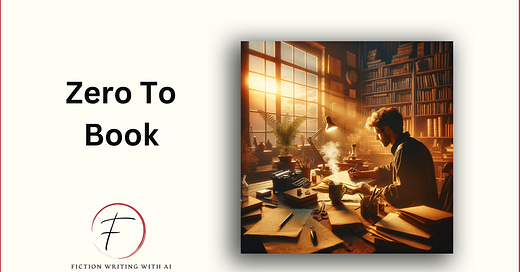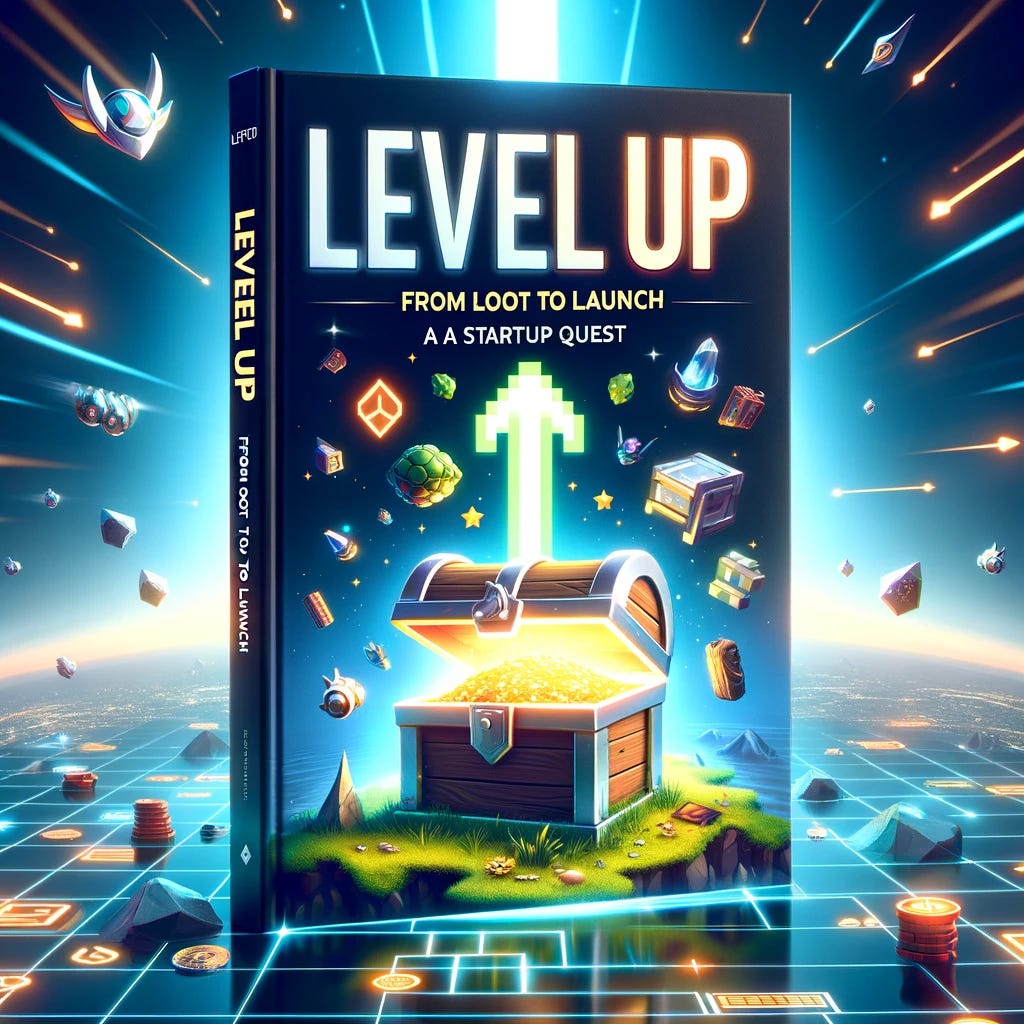Hey there!
Every great book starts with a simple idea.
That initial spark of inspiration that makes you think," I could turn this into a story." But transforming that idea into a fully fleshed-out novel is another story, especially if you're new to the writing process (pun intended).
So, I'm going to write a book in public—with AI.
You'll get a behind-the-scenes look as I write a novel from scratch. We'll walk through every part of the creative process, from the initial seed of an idea to developing it into a cohesive story concept, outlining the plot and characters, and writing the book chapter by chapter.
I'll do it all in the open, documenting my progress and creative decisions along the way. Then, you can apply the same techniques and processes to your writing project.
The goal is twofold.
To write a novel.
To give you a roadmap.
So, where do we start?
5 Steps To Begin The Novel Writing Process
There are 5 steps you need to follow to get started.
We’ve covered a few of them in previous FWWAI issues. I will point you to each post as we walk through this so you know where to find them if you need help.
Let’s go.
Step 1: Start With A Story Idea
“Even when you begin with an abstract idea, you must follow it to a character, a setting, a situation, and an emotion before there can be a story.” - Sci-fi writer Damon Knight, from Creating Short Fiction.
Every story needs an initial concept to build upon.
For example:
A Character: The hero, anti-hero, young child, or even an animal.
A Location: Dystopian city, haunted house, or a house in the "burbs."
A Situation: Quest, moral dilemma, or struggle to survive, coming of age, or a battle between good and evil.
A Feeling: Love, fear, loneliness, redemption, hope, etc.
Your initial idea may stem from one or more of these components, but you'll need to develop all four to create a well-rounded story.
Having just one of these elements is like holding a single puzzle piece. You'll need to combine them all to create a cohesive picture. If you are having trouble deciding, start with this simple sentence:
I'd like to write a story about…
Then, spend 10 minutes brainstorming characters, locations, emotions, or situations.
For this series, I've decided to fictionalize my journey from game enthusiast to founder and entrepreneur.
I recommend starting with something familiar because you'll have plenty of context and threads from which to pull. If you are writing science fiction, you'll have to use your imagination. However, you can still start with the characteristics of a real-life person or setting for inspiration.
So, what is it for you?
Name a character, a setting, a situation, or an emotion.
Step 2: Refine Your Story Idea
Once you have the seed of an idea, the next step is to experiment with different combinations and see how they interact and influence one another.
For example, here's how I'm thinking about my story:
Character: A video game enthusiast.
Setting: A major metropolitan US city.
Situation: Starts a content writing empire under stress.
As you combine these elements for your story, you may find that it feels bland. If that's the case, don't be discouraged! Use this as an opportunity to refine your idea.
For example, I could adjust one or more of the core elements in my story.
Instead of a gaming "fan," my character could be a pro esports player. The struggle to transition into a new career path after years of gaming could add a compelling personal conflict. And rather than a random major city setting, I could specify a location known for its gaming culture, like Seoul or Tokyo. Setting the story in a gaming hub could contrast the virtual gaming world nicely with real life.
At this stage, I'm intentionally not overthinking it.
I'm building momentum.
The key is to experiment until you arrive at a combination of character, setting, and situation that you'd be excited to pursue.
Step 3: Choose A Plot Archetype
Now that your idea is starting to take shape, you can start to think about what sort of story will fit.
Ask yourself, “What Plot Archetype do I want to use?”
Hero’s Journey
Rags To Riches
Identity Crisis
Love At First Sight
Etc.
Plot Archetypes are storytelling structures that have been used over and over again in storytelling history. The reason they are so helpful is because readers (and consumers of anything, in any industry) are always looking for things that are “similar” to what they already like—but “different” enough that they seem fresh and new.
Here’s my answer:
The Hero’s Journey
Again, I’m keeping it simple. The Hero’s Journey is a well-traveled path that is proven to work. So, I will start here.
Click here if you want help brainstorming a Plot-Archetype for your story.
Step 4: Choose A Sub-Genre
Of all the decisions you’ve made so far, choosing a Sub-Genre is the most important.
Your Character, Plot, and Setting differentiation is built on your Sub-Genre. For example, choosing “Medical Military Romance” will give you very different ideas for characters, plot points, and settings than “Medieval Vampire Romance.” Which is why you should make this strategic choice first.
For my story, I’ve selected the Status Genre and a Sub-Genre of Startup Fiction. Here’s how 30 year veteran editor for the Big Five publishing houses and Story Grid creator, Shawn Coyne describes this genre:
“The Status story concerns a single protagonist’s quest to rise in social standing and the price he or she must pay in order to do so.”
This “felt'“ like a best-fit genre based on my initial idea, so I will start here.
You can spend more time on this decision if you want. I’m prioritizing speed, so I can start working. I’m open to changing my mind based on how the project evolves or feedback I get from others.
The goal is to keep moving forward without getting stuck on this one decision.
Trust your gut.
Click here if you want help brainstorming your Genre/Sub-Genre. And if you want to dig into the Story Grid genre definitions, you can check those out here.
Alright, you might not realize it but by completing these first 4 steps you already have 50% of the “decisions” you need to make in your story, done.
You know “what kind” of story it is (Sub-Genre).
And you know “what needs to happen” in that story for it to be interesting to the reader (Plot Archetype).
Now, it’s time to generate a logline!
Step 5: Draft A Logline
A logline is a one-sentence summary of your story that introduces the protagonist, touches on the main conflict, and hints at the outcome of your story—all in about 25-30 words.
These 5 elements are the only thing you need to write an effective logline.
THE WHO: Your protagonist & antagonist.
THE WHAT: The problem that pushes the protagonist into action.
THE WHERE: The time / place / setting of your story.
THE HOW: The central conflict the protagonist must overcome
THE WHY: The goal the protagonist hopes to achieve.
And when you put them all together, they fit into this simple little template.
In a (SETTING) a (PROTAGONIST) has a (PROBLEM) caused by (an ANTAGONIST) and (faces CONFLICT) as they try to (achieve a GOAL).
All you have to do is fill it in!
And if you are not sure what all five of these pieces are yet, that’s ok. Start with what you have and use this prompt to help you generate different options.
My working logline is:
When a video game enthusiast turns their passion into a content writing empire, they must navigate the fine line between obsession and motivation to avoid a personal and professional crash.
I even came up with a working title, sub-title, and a book cover to start bringing things to life.
Title: Level Up: From Loot To Launch
Sub-Title: A Startup Quest
Cover:
Pretty cool, right?
Here’s the prompt I used:
I need help coming up with title and sub-title ideas for my {Sub-Genre} novel.
Here's a brief overview of my story:
{Insert your logline. Add character, setting, etc. details.}
Here are some initial title ideas I was thinking about:
{Insert any ideas you have}
There’s a 99% chance you won’t land on the perfect title on the first try, so work with AI and explain what you want more of or less of.
Once you land on a working title, you can quickly create a book cover using this prompt with ChatGPT / GPT-4.
I need help creating a book cover.
The title of my book is {Title / Sub-title}.
Now, please create a book cover.
Don’t stress over your title and cover image; we’ll refine the title when we get into the character transformation.
But for now, this is a creative process, so be creative if you want!
Next Steps
From here, we'll start expanding outward.
Overall Plot outline
Character backstories
Chapter by chapter outline
Etc.
In each issue, we'll move the story forward 1 step.
Most people think writing books is some magical, mystical process that only a select few super-talented people can master. But really, it's just a skill like anything else, and that means it can be broken down into steps that anybody can learn. Once you know how to do it, writing becomes way more doable.
That's what I'm trying to help with in this series—making it easier for anyone to write a novel with AI!
So, watch your inbox every Tuesday and Friday and follow along every step of the way. By learning how to take a book from concept to publication with a little help from AI, you'll have the power to turn your own ideas into reality faster than you thought possible.
The only remaining question—what story are you going to write?
Let me know in the comments.
Chat soon,
–Nicolas Cole
PS…we’d love your input on how we could make Fiction Writing With AI even more useful for you! So please leave a comment with:
Ideas you’d like covered in future editions
Your biggest takeaway from this edition
We read & reply to every single one of them!








Clay Golem awoke in a 7 foot tall clay shell with no memory in a strange Fantasy world and must find The Great Wand if he is to have any chance to regain his memory, his body, and his life, but faces the evil Archmage Melchior who will do anything to get the wand first.
https://silentvanitye.com/temp-ai-book-cover-for-the-blue-golem/
This is a great idea. I know a lot of people are trying to figure out ways to use AI to help them with their writing.